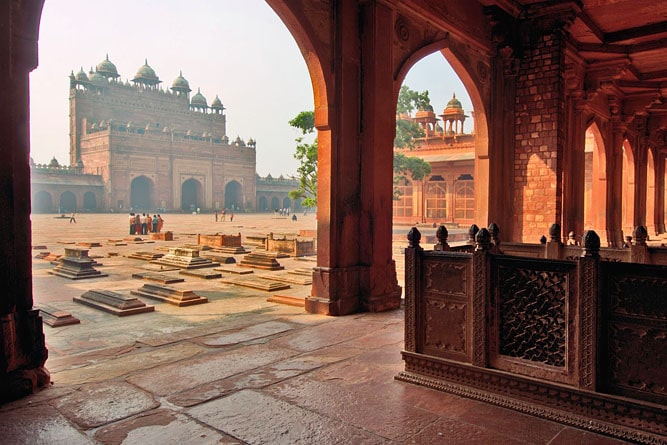Fatehpur Sikri
Historic site, 39 km from Agra
must-see attraction
Opening hours: dawn-dusk
Address: Fatehpur Sikri, Uttar Pradesh
Ticket price: Indian/foreigner ₹50/610, video ₹25
Visit duration: People typically spend 1 to 2 hours here
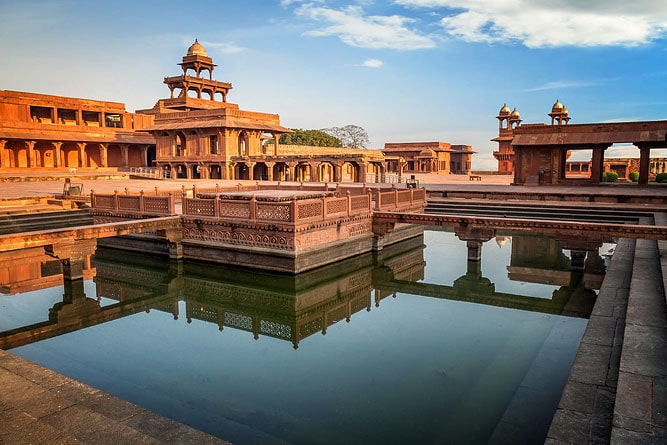
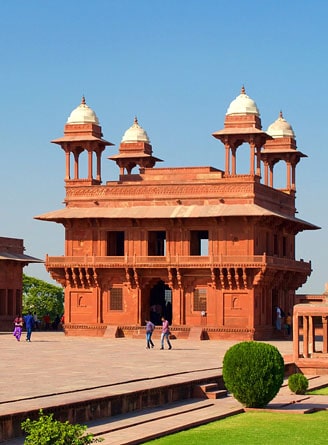
About Fatehpur Sikri
Fatehpur Sikri is a town in the Agra district that became known as the "City of Victory" after Akbar emerged victorious during the Gujarat campaign in 1573. The majestic fortified ancient city sketches an uninterrupted row of gardens on the left bank of the river Yamuna, connected to the capital of the Mughal dynasty both by boat and by land. The city is an Indo-Islamic masterpiece that was assembled primarily to afford leisure and opulence to its prominent residents.
Fatehpur Sikri was recognised as a World Heritage Site by UNESCO in 1986.
History of Fatehpur Sikri
Fatehpur Sikri was established as the capital of the Mughal Empire in 1571 by Emperor Akbar until he abandoned it in 1585 because of a campaign in Punjab. Afterwards, it was completely forsaken in 1610. The town was occupied by a village called Sikri which gave the place its name.
However, a survey by the Archaeological department of India found temples and commercial centres that imply that the village has been inhabited since the iron age of India. The Sungas ruled the village before it was governed by Sikarwar Rajputs from the 7th to 16th century until the arrival of the Mughal emperor. The East India Company utilised the town as an administrative centre from 1803 until 1850. The town evolved into a city from 1865 to 1904 and was later established as a Nagar Panchayat or the town council.
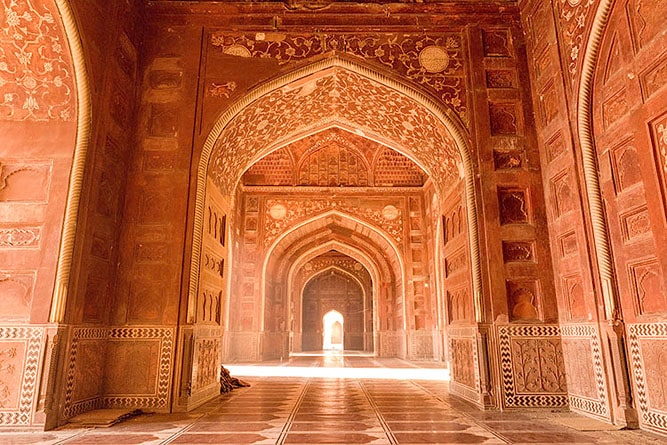
Architecture of Fatehpur Sikri
Fatehpur Sikri is 3 km long and 1 km wide and is enclosed by a 6 km wall on three sides with the fourth side protected by a lake. The city sits on a 40 m high cliff and descends in a rhombus-like area.
The architecture of Fatehpur Sikri reflects the Timurid forms and styles blended with Gujarati influences. The city was built with red sandstone. The edifice unifies the Hindu and Islamic architecture which paints the scenes of Mughal court life of the royal and noble residents.
The city can be accessed from the Delhi Gate, the Chor Gate, the Agra Gate, the Lal Gate, Birbal's Gate, the Gwalior Gate, Chandanpal Gate, the Tehra Gate and the Ajmeri Gate. The city comprises important edifices which are both religious and secular.
Buland Darwaza is settled on the southern wall which is 177 feet tall. The gateway observes the successful campaign in Gujarat by emperor Akbar. It bears inscriptions in the archway. The central entrance constitutes three arched doorways. The Horseshoe Gate at the centre is the largest, maintaining the tradition of nailing horseshoes for fortune. A deep well can be found to the left of the gateway while a courtyard beyond the wall adjoins it to the Jama Masjid.
Jama Masjid or Jama Mosque, 1571–72, is the congregational mosque, which was one of the early edifices that were constructed at the site. The mosque was assembled following the Indo-Islamic structure. The edifice comprises an Iwans around a central courtyard, a row of chhatri over the mosque, three mihrabs in each of the seven bays and a large central mihrab covered by a dome. The walls are inlaid with white marble in geometric patterns.
Within the courtyard of Jama Masjid is a white marble-covered tomb of the Sufi saint, Salim Chishti (1478–1572). The tomb shelters the grave of the Sufi saint which is enclosed by a decorated wooden ceiling rimmed with mother-of-pearl mosaic and encircled by a gallery for circumambulation. The single-storey structure has a dome, carved Jalis with a detailed geometric design, white marble winding brackets to support slanted eaves around the parapet, thirty-six small domed chhattris and an entrance to the south. The tomb houses several graves of unidentified male offspring of Shaikh Salim Chishti. The mausoleum of the Gujarat Sultanate period from the early 15th century influenced the architecture of the tomb.
Diwan-i-Aam, Hall of Public Audience, is a pavilion-like multi-bayed rectangular layout with a large open space whereas, the Diwan-i-Khas, Hall of Private Audience, is a basic square edifice with four chhatris on the canopy. The central pillar of Diwan-i-Khas has a quadrilateral plinth that evolves into an octagonal pole carved with geometric and floral designs. It has 36 winding brackets to support a circular podium for Akbar which is attached to each corner by four paths. Spokespeople of different religions discussed their faiths in front of Akbar.
Ibadat Khana, House of Worship, was a conference room built in 1575 where the bases of an unexplored Syncretistic faith, Din-e-Ilahi, were applied by Akbar.
Anup Talao, an ornamental pool, was built by Raja Anup Singh Sikarwar. It had a central podium and four bridges attached to it. The pool envelopes some of the royal enclaves including Diwan-i-Khas, Aankh Michauli, Khwabgah or the House of Dreams, Akbar's residence and the Panch Mahal and the Astrologer's Seat located at the south-west corner of the Pachisi Court.
Mariam-uz-Zamani's Palace was the residence of Akbar's Rajput wife, which depicts the influence of Rajput. It is built around a courtyard, which also has a Hindu temple and a platform for tulsi, a sacred Hindu plant for worship. The palace was internally linked to the residence of Akbar.
Naubat Khana or a drum house was the imperial entrance where musicians played the drums to announce the arrival of the Emperor. It is settled along the Hathi Pol Gate or the Elephant Gate at the southern entrance of the complex.
Panch Mahal is a five-storied grand edifice built for the royal ladies, where each storey slowly decreases in proportions until the last storey becomes a single large-domed chhatri. The floors have 176 detailed carved columns on each floor that support the structure.
Birbal's House was the residence of Akbar's famous Hindu minister. The edifice has horizontal slanting sunshades and frames which support them.
Hiran Minar or Elephant Tower is a circular tower wrapped with stone protrusions in the shape of elephant tusks. According to tales, it was a memorial to Akbar's favourite elephant.
Other edifices comprised Pachisi Court, Taksal (mint), Karkhana (royal workshop), Daftar Khana (Records Office), Darogha's quarters, Khazana (Treasury), Hammam (Turkic Baths), stables, caravanserai, Hakim's quarters.
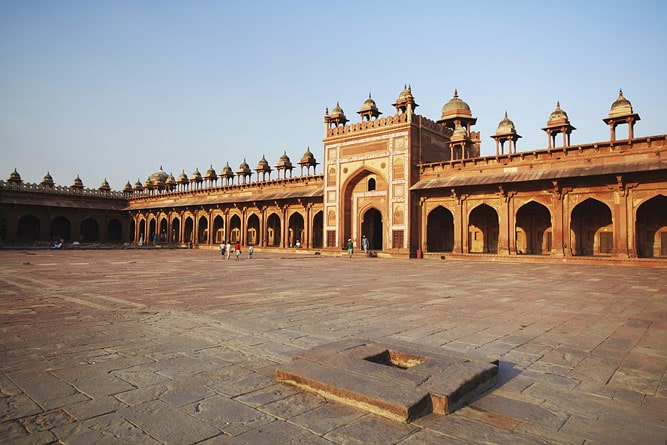
Entry fee and timings
The fort is open from Monday to Sunday from 6:00 am to 6:00 pm. The entry fees for Indian and SAARC and BIMSTEC tourists are ₹50 while for a foreign tourist it is ₹610. The nominal charge for video is ₹25.
Facts and tips about Fatehpur Sikri
- Akbar initiated the construction of a sacred compound in the village of Sikri to celebrate the Sufi saint Sheikh Salim Chishti who had foreseen the birth of the successor of the throne, Emperor Jahangir.
- The tomb of Salim Chishti contains a red sandstone tomb of his grandson Islam Khan I, son of Shaikh Badruddin Chishti who became a general of Jahangir's army.
- The Marquess of Hastings instructed the restoration of monuments at Sikri in the early 19th century.
- Wear comfortable footwear since there are so many historical edifices to visit and beware of tour guides as they happen to be very persistent and expensive. They also feed wrong information.
How to reach Fatehpur Sikri
Fatehpur Sikri can be reached from Agra in less than one hour by car. Jaipur is a 3.5-hour drive away and it is slightly longer for Delhi.
See location on Google Maps
Other attractions near Fatehpur Sikri
- Agra - 39 km
- Chand Baori Stepwell (Abhaneri) - 124 km
- Jaipur - 203 km
- Delhi - 221 km
FAQs about Fatehpur Sikri
1. Why was Fatehpur Sikri abandoned?
There was a water shortage in the area because of which the residents started to leave Fatehpur Sikri and eventually by 1610, it was completely abandoned.
2. Is there any place to eat near Fatehpur Sikri?
Yes, there are many good restaurants to eat near the historical site.
3. What is not allowed to carry to Fatehpur Sikri?
Food, cigarettes, tobacco, liquors, knives and electrical goods are not allowed to be carried inside Fatehpur Sikri.
